Remelana jangala (Horsfield, 1829) - µÜ¦Ç½º - Chocolate Royal
| Introduction | The Butterfly | Courtship and Mating | Ovipositing behaviour | Voltinism | Food plant | Early stages | Acknowledgment | Reference | Plates |
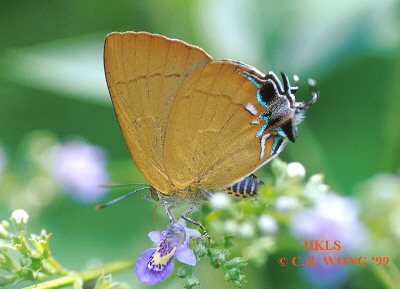
Reprint from FUTAO No. 28
Entomological reports of FUTAO-KAI
C/O Hiroto HANAFUSA - 688-2, Tashima, Tottori-shi, Tottori, 680-0804 JAPAN / September 24, 1998
A brief note on the life history of Remelana jangala(HORSFIELD) Lepidoptera, Lycaenidae in Hong Kong, PRC
James J. YOUNG - 20/F Tung Wai Comm. Bldg., 109-111 Gloucester Road, Wanchai, Hong Kong, PRC
Abstract
A summary of the life history of Remelana jangala (Lycaenidae: Theclinae) is described and illustrated by colour photographs.
Key Words Lycaenidae, Remelana jangala, life history, Hong Kong, PRC
Introduction
The distribution of Remelana jangala (HORSFIELD) is very wide, covering a vast area across Nepal, NE India, Burma, Thailand, Malaysia, South China, Philippines and Indonesia (BASCOMBE,1995). Twelve subspecies have been recognized (D'BRERA,1986).
The Butterfly
Remelana jangala is a medium-sized lycaenid with deep shiny purple colour on the upper wings suffused with black margins. The underside is light to dark brown with a post- discal line on both wings. There are two prominent black tornal spots on the hindwings with two tails on each wing. The butterfly is distinguishable from species of Tajuria by its hairy eyes (CORBET & PENDLEBURY, 1992). The female is generally larger than the male and has more purple extending further towards the margin of the forewings. No seasonal forms exist though the butterfly may take on a lighter tone during the drier months.
The butterfly is generally found in lowlands and coastal marshes. Its flight is erratic and it does not fly far when disturbed. It tends to settle on leaves of nearby shrubs and is usually easy to reach. Both sexes seldom visit flowers. However, individuals have been found feeding on Mikania guaco (DESC.) a common climbing composite with tiny clusters of white flowers blossoming in November to early December.
Courtship and Mating
No definite courtship or mating behaviour has been observed, although, males have been seen chasing females around before disappearing in the distance. Hill topping is not evident for this butterfly, nor are the males found visiting mud puddles.
Ovipositing Behaviour
A female was observed in Lung Kwu Tan, Tuen Mun on 27th July 1989 at around 3:00 p.m. laying eggs between young shoots of Litchi chinensis, the Lychee tree. It flew and settled on the edge of a small branch. It then crawled and bent its abdomen between shoots and laid a single egg. It repeated this action and laid two eggs simultaneously before flying off.
A similar instance was also observed in Tai Tan, Wong Shek Pier in Sai Kung around 10:30am on 11th November, 1991. The female was observed laying eggs on Kandelia candel, a typical mangrove plant. It settled on a very young leaf of the plant and laid a single egg on the underside. It then flew off and did not return. On searching, eggs were also found on leaf buds of the host plant.
Voltinism
The butterfly is very common in Hong Kong. It is generally seen from September to November and is rarer during the rest of the year. However, eggs are collected and found throughout the year, which suggests that the butterfly has many generations in a year and may be very localized. The reasons for fewer sightings during the spring and summer months may well be the high level of parasitic attacks. It is found that eggs are highly parasitized and subjected to over 80% casualty on random collecting in the wild. The different timing of new foliage and flowering seasons of its host plants may also limit the availability of its food sources and thereby the population of the butterfly.
Food Plant
The larvae are found to feed on a variety of host plants. Some feed on leaves and others on flower buds. This may depend on the timing of flowering and new foliage of food plants. Larvae are found feeding on the very young leaves of Litchi chinensis (Sapindaceae), Cleistocalyx operculata (Myrtaceae) and Kandelia candel (Rhizophoraceae). Some larvae are also found feeding on the flower buds of Eurya jarponica (Theaceae) in the autumn. The following description of the early stages is based on the rearing of larvae on Litchi chinensis, a local fruit tree commonly found throughout the New Territories, under indoor controlled conditions from December to February with temperature ranging from 14 to 24 centigrade.
Early stages
Egg: The egg is light green in colour when freshly laid. It will turn white after an hour or so. It is dome- shape, sculptured with pits, and flattened on the bottom, with a micropyle on the top. It measures about 0.8mm in diameter and 0.5mm in height. The caterpillar will emerge after about 6 days.
Larva: The 1st instar has an elongated body, ridged and feathered with, simple hair-like setae, and tapering towards the end of the abdomen. It is pale yellowish in colour with shade of a longitudinal line running from the prothorax to the end of the abdomen separating two rows of ridges on the back of the body. The head is yellowish in colour with a black dot on each side near the ocelli. The emerging larva will consume its eggshell and will feed on the epidermis of the leaf. It will only feed on very young leaves of its food plant throughout the larval stage, unless it is laid on Eurya jarponica, of which the larva will feed on the flower buds as the alternative food source. The larva tends to stay on the underside of the leaf and does not wander far to feed. The 1st instar lasts about 3 days. It measures from about 1.5mm to 2.2mm. The larva will consume its skin but not its head capsule after each moulting. The larva is solitary.
The 2nd instar takes about 4 days to complete and measures up to 4mm. The long feathered simple seta has shortened and the larva becomes broader. The head capsule and the prothorax turn brownish in colour.
The 3rd instar lasts another 4 days. The ridges on the back of the body now subside and the larva is more yellowish in colour. It measures up to 6mm in length.
The 4th instar also lasts for 4 days. The larva is yellowish in colour and the prothorax is totally brownish. It has a broader body and the longitudinal line on the dorsal surface starts to fade. A slit-like honey gland on the 7th abdominal segment now appears. It measures up to 1.2cm.
The 5th and 6th instars last about 7 and 12 days and grow up to 1.7cm and 2.5cm respectively. The larva has now turned greener and its appetite is enormous. The slit-like honey gland and air spiracles on the dorsal and lateral surface are more conspicuous. Black tree ants Polyrachis dive (Formicidae:Formicinae) have been observed attending to larvae feeding on Cleistocalyx operculata, a tree found near streams and Fung Shui woods around villages in the New Territories. Fung Shui woods are patches of vegetation surrounding villages, preserved for harmony with nature in Chinese culture. The ants will caress the larva with their tarsi and antennae while a droplet of honeydew will be released from the eversible gland of the stimulated larva. A droplet of honeydew will be released as frequently as every 10 seconds from the stimulated larva. The association with ants, however, is not evident in the host plant of Litchi chinensis. It may be that the larvae are only attended by ants occasionally, and do not always depend upon them for survival. All larvae reared indoors survived without the aid of ants. (However, in an indoor environment the natural predator from which the ants protect the larvae will be absent, therefore it is not surprising that the larvae can survive without ants in indoor conditions.)
Pupa: The larva will remain motionless for about 2 to 3 days before pupation. It will then pupate on the upper surface of the dark green mature leaves of the host plant, attached by the cremaster at the end of the abdomen. The dark green leaves provide the perfect camouflage for the green pupa. The pupa measures from 1.3cm to 1.5cm with females tending to be larger. The adult will emerge in about 14 days. The duration will be shorter during the summer months, when it takes the butterfly only a week to emerge from its pupa. When it is time to emerge, the entire colour form of the butterfly will appear in the transparent pupal case. It will then emerge within the next 24hours in the early hours of the morning. The complete cycle from egg to adult lasts for 54 days.
Acknowledgment
I thank Dr. John FELLOWES for identifying ants specimens and Mr. Graham REELS for his constant advice and support.
Reference
1) BASCOMBE M.J. 1995 Checklist of the butterflies of South China - Memoirs of the Hong Kong Natural History Society, page 92.
2) CORBET A. S. & PENDLEBURY H.M. 1992 The Butterflies of the Malay peninsula-4th edition revised by J. N. Eliot, Kuala Lumpur, pages 317-318.
3) D'BRERA B 1986 Butterflies of the Oriental Region Part III. Hill House, page 618.
4) THROWER S. L. 1983 Hong Kong Climbing Plants, The Urban Council, Hong Kong, page 93.
5) Hong Kong Herbarium 1993 Checklist of Hong Kong Plants. Agriculture and Fisheries Department Bulletin No. 1, 1993.
Plates
Life history of Remelana jangala (HORSFIELD)
|
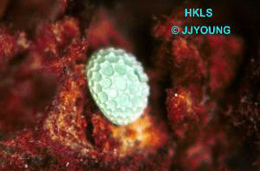
|
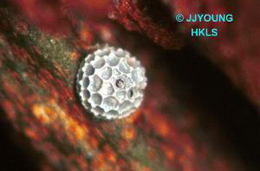
|
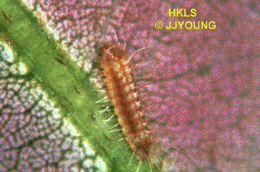
|
|
1) Freshly laid egg - ventral view |
2) Egg - dorsal view |
3) 1st instar - just hatched and with the black dot on ocellus of the forehead in view |
|
|
|
|
|
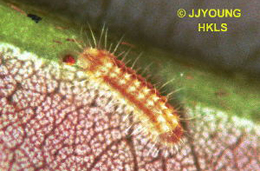
|
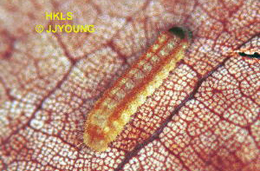
|
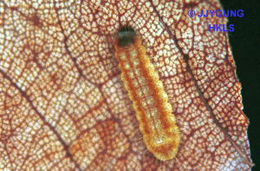
|
|
4) 1st instar - dorsal view |
5) 2nd instar - ventral view |
6) 2nd instar - dorsal view |
|
|
|
|
|
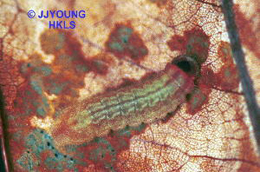
|
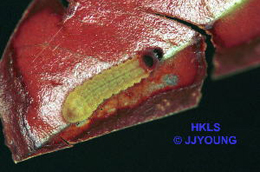
|
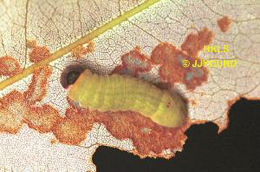
|
|
7) 3rd instar - dorsal view |
8) 4th instar - dorsal view |
9) 5th instar - dorsal view |
|
|
|
|
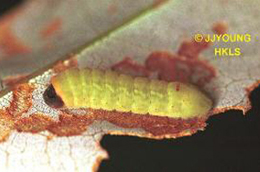
|
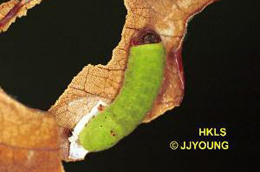
|
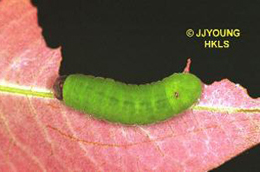
|
|
10) 5th instar - ventral view |
11) 6th instar- after moulting |
12) 6th instar - dorsal view |
|
|
|
|
|
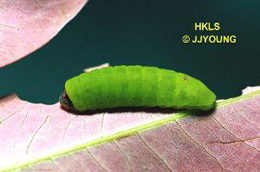
|
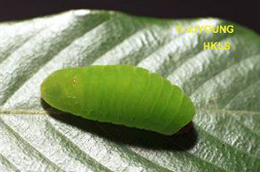
|
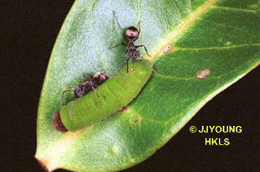
|
|
13) 6th instar - ventral view |
14) 6th instar before pupation |
15) 6th instar larva attending by black tree ants |
|
|
|
|
|
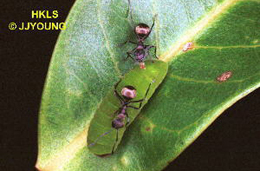
|
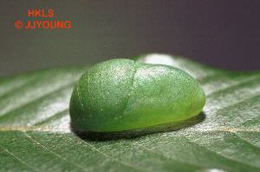
|
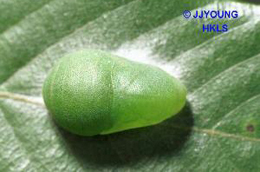
|
|
16) 6th instar larva with ant feeding on the honey dew released by the slit liked honey gland on the dorsal surface of the body |
17) Pupa - ventral view |
18) Pupa - dorsal view |
|
|
|
|
|
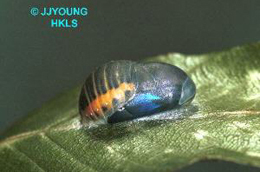
|
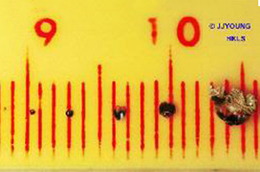
|
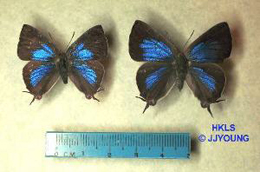
|
|
19) Butterfly ready to emerge from pupal case |
20) 1st to 6th instar head capsules - 1 space=1mm |
21) Upperside of expupa male and female |
|
|
|
|
|
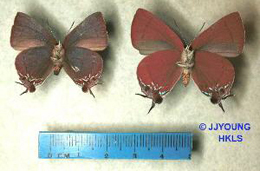
|
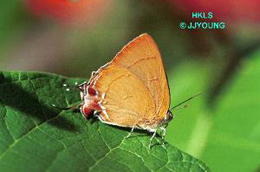
|
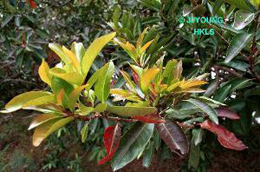
|
|
22) Underside of expupa male and female |
23) Young leaves of Cleistocalyx operculata (ROXB.)MERR. PERRY |
24) Kandelia candel (L) DRUCE |
|
|
|
|
|
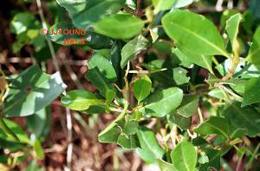
|
|
|
|
25) Adult butterfly at rest 25/11/96 KARC, Shek Kong, NewTerritories |
|
|
(Prepared by J.J. Young) This page was created on 19th December 2000 and last updated on 19th December 2000.
©2004 Hong Kong Lepidopterists' Society Limited |